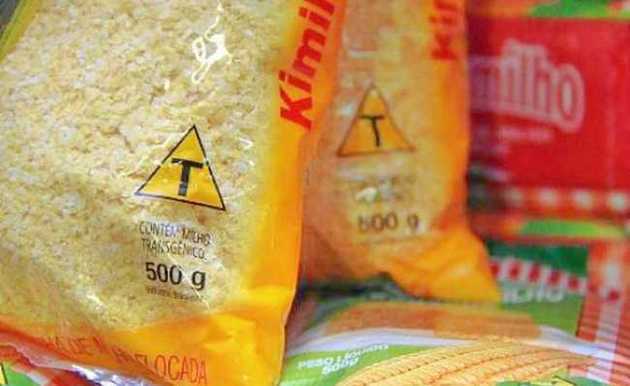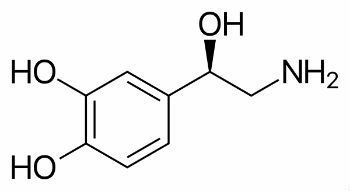Cnidarians or coelenterata (phylum Cnidaria) are multicellular organisms that live in aquatic environments, the vast majority being marine.
There are more than 11,000 species of cnidarians worldwide. The main representatives of the group are jellyfish, corals, sea anemones, hydras and caravels.
General features
The main habitat of the cnidarians is the shallow tropical water marine environment. Few species live in fresh water. None are terrestrial.
The cnidarians have a specific type of cell in their tentacles, the cnidocyte. These cells release the nematocyst, a kind of capsule that contains a filament with thorns and a stinging liquid.
The nematocyst is responsible for injecting toxic substances that aid in prey capture and defense. In humans, it can cause burns.
The cnidarians have two morphological types, the jellyfish and the polyps. Some species can show both forms at different periods of life.
Jellyfish are represented by swimming organisms such as jellyfish. They have a gelatinous bell-shaped body, with tentacles on its margin and a central mouth.
Polyps are sessile organisms, that is, fixed to a substrate. They have a tubular shape, like sea anemones. They can live in colonies or isolated.
The cnidarians do not have circulatory, digestive and respiratory systems.
Find out more about the Animal Kingdom.
food
Cnidarians have an incomplete digestive system, they have no anus.
The digestive system of cnidarians is made up of a cavity with a single opening. This place serves both for the entry of food and for the exit of waste.
When they capture the food, with the help of the tentacles, they introduce it into the digestive cavity. Hence, they are partially broken down by the action of enzymes, and the nutrients are distributed to all parts of the body.
The animal only returns to feed after eliminating the waste.
Cnidarians are carnivores. They feed on particles suspended in water and small aquatic animals.
Breathing
Cnidarians do not have a respiratory system. Gas exchange takes place directly between each cell and the medium, through diffusion.
Nervous system
Cnidarians are the first animals to have neurons, nerve cells. However, your nervous system is quite simple. It is characterized by being of the diffuse type, the nerve cells form a network that is in direct contact with the sensory and contractile cells.
reproduction
The cnidarians can present asexual and sexual reproduction.
THE asexual reproduction occurs by budding. On the surface of the body there are sprouts that when they develop, detach themselves and give rise to new individuals. This type of reproduction is common in freshwater hydras and some marine anemones.
THE sexual reproduction it is possible thanks to the existence of dioecious (separate sexes) or monoecious (hermaphrodite) cnidarians.
In this type of reproduction, male and female gametes are formed. The male releases his sperm into the water, which fertilize the female egg, present on the body surface.
However, the most common is for the gametes to be found in the water, causing external fertilization to occur. The zygote develops and there is no larval stage.
Some cnidarians may present alternation of generations. They have a polyp phase, in which they have asexual reproduction, and another jellyfish phase, with sexual reproduction.
Learn more about the Invertebrate Animals.
Classes
The cnidarians are divided into four classes: Anthozoa, Hydrozoa, Scyphozoa and Cubozoa.
Anthozoa
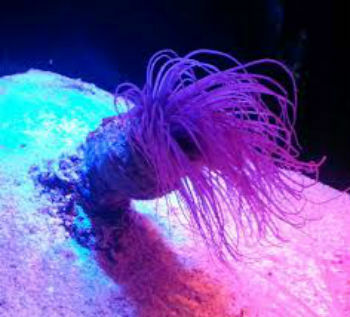
sea anemone
The Anthozoa class has the largest number of species. In this group there are only marine polyps. The main representative of the group is the sea anemone, a cylindrical animal, whose base is fixed in some substrate. At the opposite end is the mouth, surrounded by flexible tentacles.
Corals also belong to this class. They are polyp colonies that can contain up to 100,000 individuals. Therefore, corals are characterized by high biodiversity.
Hydrozoa
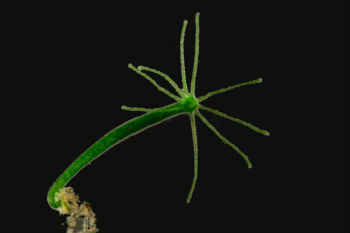
Hydra
Hydras usually remain immobile and may be confused with vegetation, especially by the greenish color of its body, which is due to the presence of unicellular green algae in its interior.
Moving their tentacles, they capture their prey, including the water flea. The few freshwater species belong to the hydrozoa class.
Scyphozoa
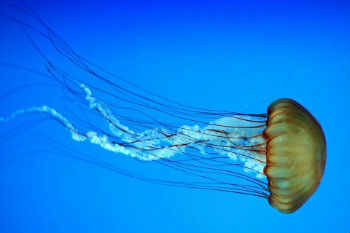
Jellyfish
The jellyfish has the appearance of an inverted dish, with the mouth in a lower position and the edges endowed with many tentacles.
Presents from 2 to 40 cm in diameter and the most varied colors. It is mobile and has a very soft body. Its tentacles should not be touched as they can cause severe burns.

Caravel
The caravels have a floating structure similar to a gas bag, with more than 20 cm in diameter. The tentacles can measure up to 9 m in length.
They have stinging cells, which can cause a painful skin burn or even kill some animals.
Cubozoa
Cubozoans are cnidarians in the form of colorless, highly poisonous jellyfish. They are predatory animals and good swimmers.
It is the least studied group. They have only 20 species.
The best known representative is the sea wasp (Chironex fleckeri), the animal with the most lethal venom in the world. Its toxin is believed to be capable of killing 60 adult humans.

Chironex fleckeri
Cnidarians and Porifers
You porifers represent another group of invertebrate and aquatic animals, which can live fixed in a substrate. They are also called sponges or sponges.
Like the cnidarians, the porifers also have few freshwater species.

